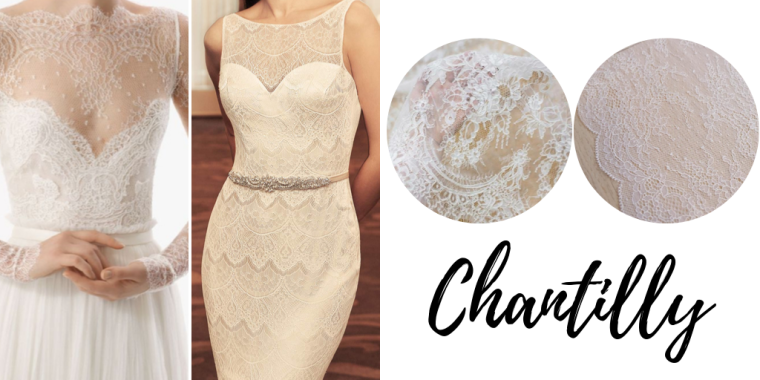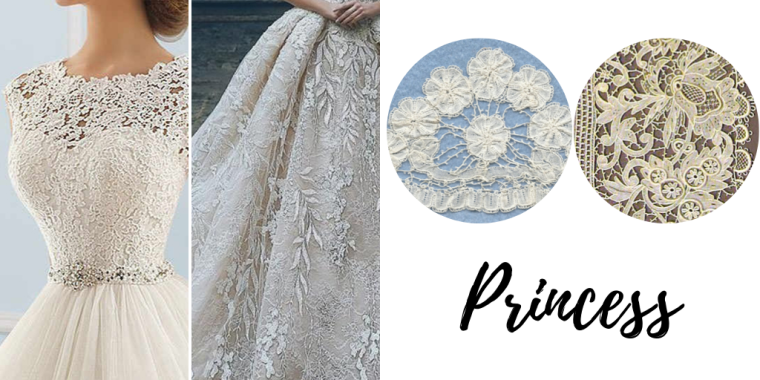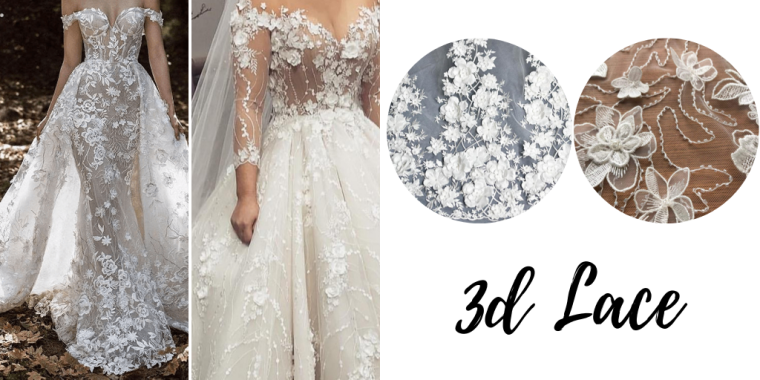
Lace 101 – All the Lace Types You Need to Know
Lace can be found in various styles and details, the majority are still made using old traditional techniques and keep the name of the town they were created in. Lace is a open-weave fabric that enriches a wedding gown and is arguably one of the key elements of your bridal attire.
Lace can be sown directly on a base fabric such as silk, taffeta, satin or on invisible tulle that will be overlayed on the gowns structure. Lace is a detailed decorative fabric with complex motifs and a net of various dimensions and shapes.
Every style and pattern is fabulous it’s unique and special way. Lace can be embroidered, interlaced with lurex, re-embroidered or corded. Whatever your choice, keep in mind that lace will alter the price of your gown.
Alencon
Also known as “queen of lace”, Alencon is a fine needlepoint lace, most commonly known for its floral motif on illusion tulle or net. It was created in the 16th century in the french region of Alencon and is perfect for details and superior layers of your wedding gown.
The definitive characteristic of Alencon is the fine cording that is applied to the outlines of the motif. Extremely delicate, Alecon has more structure and body than Chantilly lace.
Guipure
Guipure or venetian lace is a french bobbin lace elegant and robust, often used in wedding gown making. That is because Guipure doesn’t fray, it’s easy to cut and handle. Guipure is heavier and more textural, a lot more intense than other laces.
The pattern is created by a series of close, embroidered stitches onto a fine fabric that seems to disappear in the finished piece. This characteristic gives its ability to be used without a support net.
Chantilly
Created in the 17 century in the french town of Chantilly, this delicate lace is elegant and dreamy. Known for its delicate and detailed motifs, this lace will give you a very elaborate wedding gown. Chantilly has a fine cord outlining its motif. It is one of the most expensive wedding gown laces.
Embroidery
Embroidered lace use tulle backing, onto which a decorative pattern is applied using a needle and thread to form the appearance of an applique. Embroidered lace can use pearls, beading, sequins and cording. This type of lace will give your gown more character and dimension.
Lyon
French Lyon lace is created with 18 century techniques that means producers create 35 centimeters of lace per hour. Lyon lace can be made from cotton fibres and has various traditional floral details. You can incorporate iridescent beading and pearls.
Duchesse
This type of belgian lace was created for duchesse Marie-Henriette of Brabant, from whom it borrowed its name. Was manufactured from 1840 throughout the 19th century in Brussels and Bruges. It became popular because it made a cheaper alternative to french lace.
The design motifs were joined not by a mesh but by thin bars, or brides. Offers a distinct character and is perfect for romantic brides.
Spanish
Spanish lace is hard to identify because most laces used at the royal court of Spain starting with the 17th century were mostly imported from Venice ( the most important lace centre in Italy) and France.
Using lace in various religious ceremonies made spanish lace identify with floral motifs with a heavy feel (most commonly the mantilla veil).
Spanish lace centers, similar to the ones in Barcelona, were known for producing blonde lace.
Blonde lace
The name denotes the slight colouring of this lace. The original term refers to chinese silk bobbins that were not whitened. Later on the term included various types of bleached materials used to produce lace.
Battenberg
This american lace takes its name from the Battenberg family wedding that took place at the same time this pattern was created. It has a certain renaissance vibe and it’s perfectly suited for brides that want a unique bridal gown.
Brussels
Brussels lace is extremely delicate and rare. Legend says that women of 17th century used to work in the dark, avoid light which would make the fibre brittle. Today similar patterns can be created using modern techniques.
Princess
Princess lace is exclusively machine made and was created in Belgium at the end of the 19th century. With this lace we are talking about industrial lace with a lower production cost. That is why this type of lace became a favorite within the bridal industry.
It is made of straight machine-made lace tapes also called princess lace. The lacemaker bends and folds these into the shape of flowers and leaves, and sews them into position.
Soutache
Also known as russian lace this type of embroidery has a decorative character and is influenced by the military motifs. Today it can be found in various types of models and is perfect for brides that want a slight three-dimensional pattern.
Schiffli
The chemical lace is a type of lace that is created on a sacrificial fabric that later disintegrates when chemically treated, leaving behind the lace. Schiffli machines came into use in the late 19th century.
3D lace
As its name tells, this type of lace maintains its features but has an overlaid motif that created a partially three dimensional texture. This is the perfect lace for tulle skirts with a long and impressive train that will enhance the 3d effect.
Keep in mind that your wedding gown will feature a mix of two or tree types o laces and will most certainly have a unique design. What’s your favourite type of lace?


















